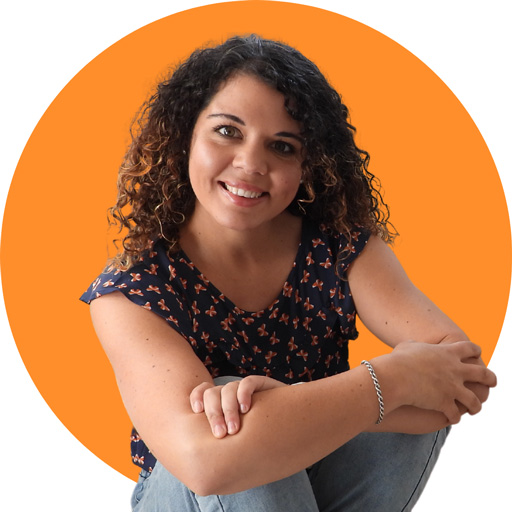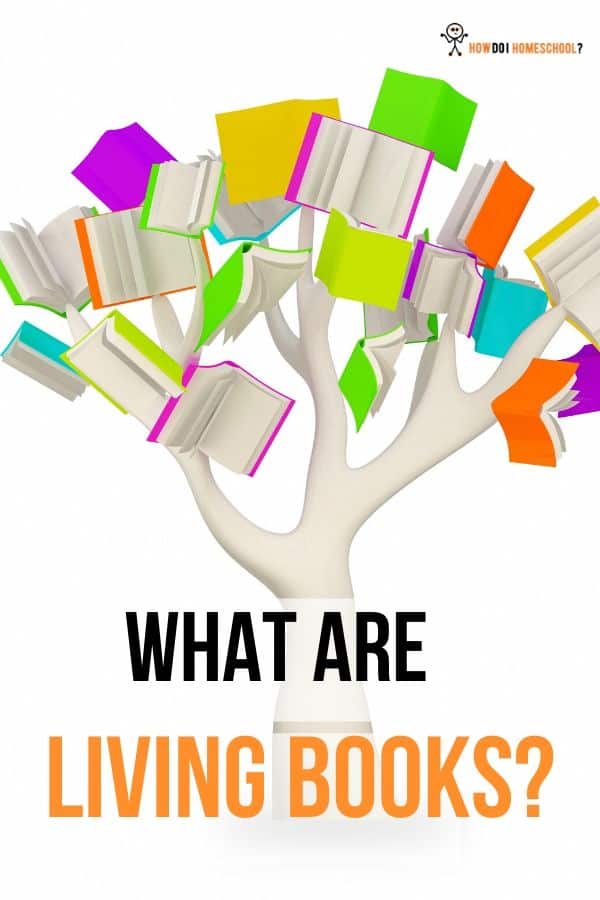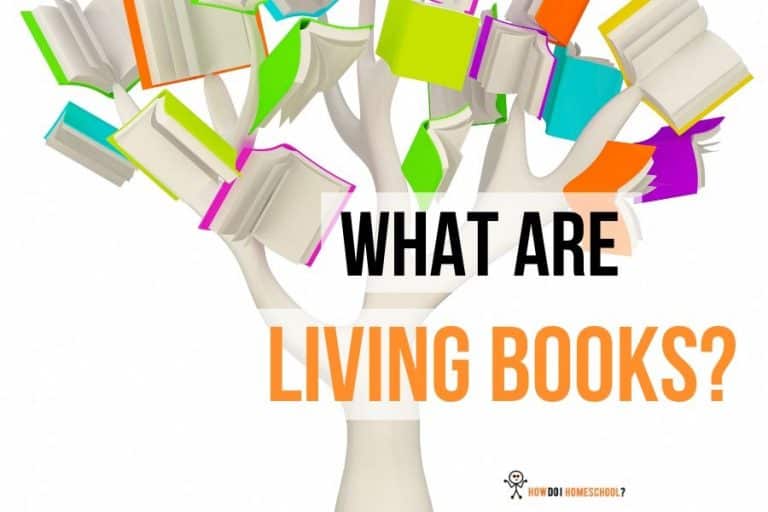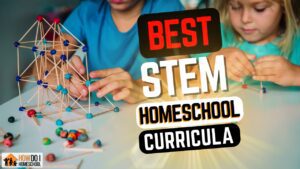One of the hallmarks of a Charlotte Mason education is teaching children concepts using particularly engaging books. These are called living books and bring a subject alive by heightening a child’s interest in the topic as they become enthralled by the storyline. As children read, they learn about the topic unconsciously. This way, they retain more information as they can tether it to an exciting story.

I hope you enjoy reading this blog post. If you want to do my course on how to homeschool, click here.
In this article, we’ll be looking at:
- What is a Charlotte Mason Living Book?
- An Example of a Living Book
- The History of Charlotte Mason and Living Books
- Where You Can Find a Charlotte Mason Book List for Homeschoolers
Let’s dive in and get started!
What is a Living Book?
A living book is a book that brings a topic to life.
Instead of reading like a dry or dead book, a living book has vitality and evokes curiosity and interest in its reader.
Living books are often written by people who:
- have a keen interest in the topic
- know the topic in-depth
- can write about the topic skillfully and in detail
- integrate stories that convey information as well as amuse the reader
A living book is a great read and will encourage children to be lifelong learners and readers.
It also gives them the confidence to dive into a tome, knowing they can tackle it (and they may even find it interesting to boot!)
What is Not a Living Book
The opposite of a living book would be an encyclopedia or a dictionary that gives you dry facts about a topic but doesn’t entertain or let you learn through a story.
It doesn’t interest you (unless you’re interested in the entry) or capture your imagination like a living book would.
Many texts children study in schools are not living books – one reason I’m not fond of school education.
They’re often written by a committee that decides what children will learn and when.
The committee isn’t always interested in the topic, but they’re interested in the child knowing that information for later or a test.
They require children to rote learn a lot of information and don’t always seek to capture their imagination.
These boring texts make learning a lot less fun than you might get with a living book.
Examples of Living Books
An example of a living book is Moby Dick.
Although many people groan over Moby Dick (and say it was their high school text they had to study and therefore they don’t like it), homeschools have more time to leisurely work their way through the book and mull over the themes and stories within.
Like many other living books, Moby Dick was written by an author who had a keen interest in the topic at hand (I think you’d have to be keenly interested in whaling to write a 585-page tome on the subject and make it somewhat interesting).
Moby Dick is an excellent example of a living book.
You can see Herman Melville has a keen interest in the topic and knows the topic well.
He writes about whaling issues clearly and in detail and integrates stories about the subject, teaching his audience about whaling.
I read Moby Dick a few years back, and I loved it.
It’s a book you’ll need time to study – but you’ll have that time when you homeschool!
Charlotte Mason and Living Books
Charlotte Mason believed children should be brought with many books around them.
This is what Mason said on reading:
A child’s intercourse must always be with good books, the best we can find. We must put into their hands the sources which we must needs use for ourselves, the best books of the best writers. For the mind can deal with only one kind of food; it lives, grows, and is nourished upon ideas only; mere information is to it as a meal of sawdust to the body. – Charlotte Mason
As such, these great books help children digest and grow from the information they learn in the pages of a living book.

Where Can I Find a Charlotte Mason Book List for Homeschoolers
You can get hold of a living book using five methods:
- searching living book lists and buying them new
- borrowing them from the library
- borrowing them from a friend
- buying used books
- searching for books that are past their copyright that you can freely download
Of course, the books you use will depend on how old your children are…you don’t want to start them on Moby Dick at age 6.
What Types of Living Books Are There?
You might be thinking you can only use living books for literature subjects. The great thing is that you would be wrong and use them for many more subjects besides literature.
You can bring so many subjects alive with great books, including:
- living science and biology books
- living math books
- living history books
- living geography books
- living technology and engineering books
For someone who struggled with math, the thought of teaching my children math using a living book is a great relief.
Beware…Living Books Require Lots of Reading by Parents
It might be worth mentioning that if you use living books in your curriculum, you need to be prepared to read these texts to your children for hours on end when they are young.
Children can’t read them themselves in their formative years, so they need parents to do it for them. This is what Charlotte Mason said on the topic:
Every scholar of six years old and upwards should study with ‘delight’ his own, living, books on every subject in a pretty broad curriculum. Children between six and eight must have their books read to them for the most part. – Charlotte Mason
So, if you’re prone to losing your voice or you’ve had throat surgery, don’t bank on being able to read constantly.
I mention this also because I heard of one mother thinking of stopping because she struggled with the constant reading.
She was considering using another curriculum for a while due to the strain on her vocal cords.
Of course, an alternative to this is signing up to Audible (banner below). If you get a monthly subscription, you can have the books read to your children instead. If you want to try it out, you can get two free audiobooks and see if it’s for you.
If this isn’t an affordable option, you can look up the titles followed by ‘audiobook’ on Youtube. Many are available for free use like this one (one of my favorites, The Little Pilgrims Progress.
When You Read, They Listen
Charlotte Mason said children should pay full attention when parents read their living book.
Mason would never have allowed children to color in, listen to music, or do other activities while the text was being read.
I wonder if this is always wise. But I think the idea is that children want to concentrate when a book is being read.
I’ve found my son, Luke, can pay attention to an audiobook and play with his Lego simultaneously.
But, learning to pay attention to what they’re hearing, and this is a Charlotte Mason skill that they’ll be able to take into their lives later on, for instance:
- When their boss does a presentation, they can listen without wandering off and thinking about other topics.
- When the pastor gives his sermon, they’ll be able to recall the message and take this into their lives in the future.
- When their husband or wife says something, they can remember what was said.
As such, full attention is an excellent habit to train in your Charlotte Mason homeschool.
How Can I Tell If They’ve Understood the Book?
Another tenet of Charlotte Mason homeschooling is narration.
Narration was Mason’s gentle form of testing where parents could ask their children to repeat back the storyline or ask them some questions about the plot.
You can also use cards or cubes to help you test your child with narration.
Indeed, I think cards and cubes make testing even more fun. It makes it more like a game!
See the narration video below for more information.
Charlotte Mason Living Books Booklist
I’ve compiled a homeschool booklist with some of the best living books. Here are some links to particular years:
- Preschool
- Kindergarten living books
- Grade 1
- Grade 2
- Grade 3
- Grade 4
- Grade 5
- Grade 6
- Grade 7
- Grade 8
- Grade 9
- Grade 10
- Grade 11
- Grade 12 Charlotte Mason Living books
Using Ambleside’s reading lists, you can easily find fun, suitable books for your homeschool.
Great Books Vs Living Books
When it comes to choosing books for education, two prominent contenders emerge:
- great books and
- living books.
There is a lot of overlap between the two (probably because Charlotte Mason trained as a classical educator).
But great books are the books favored by classical education curriculum providers.
By contrast, living books are favored by Charlotte Mason curriculum providers.
Great books are renowned for their historical significance and literary excellence. They often represent classic works that have stood the test of time and are considered essential for a well-rounded education.
On the other hand, living books, a concept popularized by Charlotte Mason, take a different approach. These books are carefully selected for their ability to engage and captivate young learners. The aim in many of them is to do habit training through engaging stories.
Living books possess a narrative style that sparks curiosity and immerses children in the subject matter, making learning an enjoyable and memorable experience.
While great books offer a wealth of knowledge and intellectual rigor, living books bring the subjects to life, creating an emotional connection and fostering a deeper understanding.
By blending education with storytelling, living books help children absorb information effortlessly and retain it long-term.
Ultimately, the choice between great books and living books depends on the educational goals and preferences of the curriculum.
Both have their merits and can play a significant role in shaping a child’s love for learning and expanding their intellectual horizons.
Want to Learn How to Homeschool?
There are two great ways t learn more about homeschooling: one is free, and one is a $67 fundamentals course.
The $67 Course
Looking to take your homeschooling to the next level? Join Rebecca Devitt’s online Homeschool Parenting Program and learn the strategies and techniques needed to make homeschooling a success! Learn more about the HPP here and signup here.
The Free Youtube Channel
Also, make sure you join the How to Homeschool Youtube channel, which will give you a fun and exciting look into the homeschool world and help homeschool your children. Check out the channel here, and don’t forget to SUBSCRIBE.
If you’re not sure where to start, start with the following playlists:
- Starting homeschool playlist
- Homeschool Methods playlist
- Homeschool Curriculum playlist
- FAQs on Homeschooling playlist
You’ll love it and find it helpful and entertaining! Discover the channel here.
Conclusion
Using Charlotte Mason living books in your homeschool will bring your educational program to life. These books can captivate your child and make them learn and retain information that is otherwise difficult to retain. These books are a way to train a child’s character and disposition. They also develop a love of learning they can carry their whole lives. As such, these books are an indispensable part of learning if you’re using a CM homeschooling style.




Are North and South by Elizabeth Gaskell or Pride and Prejudice by Jane Austin living books? Why or why not?
Yes, I would say so. Living books are educational books delivered through stories. The reason I’d argue they are so is that they teach character. Austen was great at that. They also teach amazing language skills. By reading her books you learn many phrases, new words, and turns of phrases. You also learn about a historical period and various customs. And lots more. Great question! Thanks Mercy!